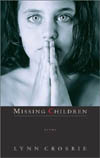Missing Children
by Lynn Crosbie
M&S, 2003Reviewed by Erin Gouthro
 In Missing Children, Lynn Crosbie uses a series of linked poems to weave a macabre tale of an unnamed man who sends letters to the parents of missing children. Each time the man writes, he promises to tell the parents the whereabouts of the child. As the collection progresses, he soon offers only perverse condolences. These poetical letters, for indeed the unnamed man has writerly inclinations, are interspersed through an ongoing narrative of poems. In Missing Children, Lynn Crosbie uses a series of linked poems to weave a macabre tale of an unnamed man who sends letters to the parents of missing children. Each time the man writes, he promises to tell the parents the whereabouts of the child. As the collection progresses, he soon offers only perverse condolences. These poetical letters, for indeed the unnamed man has writerly inclinations, are interspersed through an ongoing narrative of poems.
Those familiar with Crosbie’s previous works of poetry will find both similar poetical style and subject matter in this latest collection. And as with her
other
works, Missing Children is sure to polarize her audience. Crosbie, who makes the examination of the dark side of humanity her regular subject matter, opens the collection with a journal inscription "stories in the news this week that have been haunting
me - one was one of the most sinister things I’ve ever seen." From this point, she takes her readers through the hallways of the main protagonist’s mind and builds her characters and their circumstances through vivid imagery.
Intimation
She put down her scissors and kissed me,
her mouth flowering like a sliced radish in water,
This is one of Crosbie's strengths:
the juxtaposition of mundane routines of people and everyday household items against violence.
The effect is sometimes tragic, sometimes confrontational. Crosbie’s other main strength lies in her ability to create complex characters. In
Missing Children, the main protagonist is often a victim as much as a victimizer. The readers
may not only feel sympathy, but begin to ask themselves if they too could participate in such behaviours.
Crosbie is often lyrical. She is able to use language to create a depth and range of images as well as evoking a range of emotion. And a number of great lines can be found in the collection. For example, when Crosbie describes the predatory drive of tigers, in the poem
"4 A.M.," she creates a picture reminiscent of Blake’s famous poem
"The Tiger."
His pupils dilate as he crouches low.
A stag shifts in a bed of emerald needles
and turns.
However, at the worst points, Crosbie’s verse can read a little like a grocery list.
Bathroom
She takes a bath every night after work, lines the ledge
with movie magazines, an ashtray, loofah, and glass of gin, neat
Like a rat in her nest,
eating cheese and crackers or Fig Newtons, heedless
of the crumbs rising to the top of the water,
flecks of tobacco, soap scum.
Indeed, words seem to become only a vehicle to move the narrative along. The cadence and rhythm of Crosbie’s poems vary little from page to page throughout the collection. And after 100-plus pages the reader might begin to wonder if this work wouldn’t have been better rendered in
prose.
Erin Gouthro is the poetry reviews editor for
The Danforth Review. She lives at the edge of the world (or outside the GTA), with her husband, a cat, and a border-collie. Erin is currently attending journalism school at Ryerson University. |